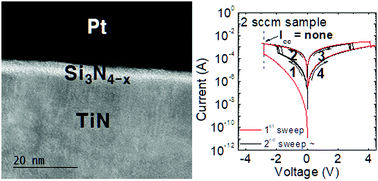Bipolar resistive switching property of Si3N4−x thin films depending on N deficiency†
Abstract
This study investigates the bipolar resistive switching property of a silicon nitride (Si3N4−x) thin film deposited by plasma-enhanced chemical vapor deposition using SiH4 and NH3 as the Si precursor and N source, respectively, at a wafer temperature of 300 °C. By controlling the NH3 gas flow rate, the optimized condition for resistive switching behaviors can be achieved. The lowering of the NH3 reaction gas flow rate induces a N-deficient Si3N4−x film, which affects the bipolar resistive switching behavior. Among the various NH3 gas flow rates, 2 standard cubic centimeters per minute produced Si3N4−x films having the optimized switching property with a self-compliance behavior, which could be obtained with the help of the series resistance induced by the parasitic resistance of the Pt top and TiN bottom electrodes. The resistance value of the low-resistance state was independent of the electrode area, suggesting the filamentary resistive switching. The high-resistance state follows the space charge–limited current mechanism. A detailed electrical analysis was performed to identify the trap depth and density for the hopping conduction. Si3N4−x is a promising material for feasible resistive switching random access memory.



 Please wait while we load your content...
Please wait while we load your content...